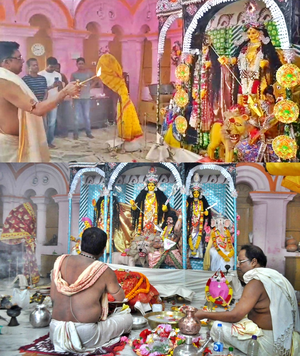Agartala: The 148-year-old Durga Puja, initiated by the then kings and subsequently sponsored by the Tripura government for the past over seven-and-a-half decades, continues to draw devotees from different parts of India and the neighbouring countries, including Bangladesh.
Tripura, irrespective of being governed by the Left or the non-Left parties since it merged with the Indian Union 75 years ago, is possibly the only state in the country where the government continues to sponsor the 148-year-old Durga Puja, which is also closely overseen by both the erstwhile royal family and the West Tripura District administration.
The ‘Bodhan’ (also called ‘Maha Sasthi’) — the welcoming of the Durga idols — the five-day long ‘Puja’ (worship) began on Wednesday at the famous Durgabari temple, located in front of the 123-year-old Ujjayanta Palace, one of the biggest royal mansions in eastern India.
The two-storeyed magnificent mansion, Ujjayanta Palace, built by then Maharaja Radha Kishore Manikya during 1899-1901 covering one sq Km area, was the headquarters of former kings. After 1949 it became the state Legislative Assembly.
After the state Assembly was shifted to the Capital complex on the outskirts of the city, the majestic mansion has now been turned into eastern India’s biggest museum conserving the history, life and culture of northeast India.
According to 59-year-old Jayanta Bhattacharjee, the head priest of Durgabari temple, a few years after the beginning of the royal era in Tripura, the kings started Durga Puja over 500 years ago.
The headquarters of the princely dynasty was first set up in Udaipur then in Amarpur then was moved to Puran Habeli and finally settled in Agartala 186 years ago in 1838 by Maharaja Krishna Kishore Manikya (1830-49),” Bhattacharjee told IANS.
Bhattacharjee’s forefathers have performed the role of head priest or priest to worship the Durga idols in the Durgabari temple for six generations.
As per norms, West Tripura’s District Magistrate (DM) and Collector before starting the rituals of Durga Puja have to report in writing about the preparations at Durgabari to the former royal family and submit a final report after completion of the five-day puja.
The DM, who is called ‘Sebayet’, is the main organiser of Durgabari puja.
Now this traditional practice has been slightly changed. However, every detail of the Durga Puja is approved by the surviving elderly royal family member, Bibhu Kumari Devi.
Bhattacharjee, son of former head priest late Pandit Dulal Bhattacharjee, said it is on the final day of Dashami that the real splendour of the festival unfolds.
The idols of Durgabari that lead the Dashami procession are the first to be immersed at Dashamighat here with full state honours, with the state police band playing the national song.
He said the state government like in previous years has sanctioned the funding this year too for the Durga Puja at this royal temple.
“A young buffalo, several goats and pigeons are sacrificed during the five-day festival at Durgabari in the presence of thousands of devotees — all at government expense,” Bhattacharjee informed.
Nonagenarian Salil Debbarma, a renowned Historian and writer, said that Tripura is the only state in India where the state government, be it of the Left or non-Left parties, has been funding the Hindu puja.
He said the tradition has been going on since erstwhile princely ruled Tripura’s merger with the Indian Union 75 years ago.
“At the end of the 517-year rule by 1,355 kings, on October 15, 1949, Tripura came under the administrative control of the Indian government after a merger agreement signed between Kanchan Prabha Devi, then regent Maharani, and the Indian Governor General,” Debbarma told IANS.
The merger agreement made it mandatory for the Tripura government to continue the sponsorship of temples run by the Hindu princely rulers. This continues even 77 years after India’s Independence.
A full-fledged division — Debarchan Vibhag — under the district magistrates in four of Tripura’s eight districts now bears this responsibility and the entire expenditure of over 15 temples, including that of Durgabari, is met by the government.
Ahead of starting the five-day-long worship of Durga and her four children, a procession led by the head priest, escorted by Tripura Police, goes to the palace to seek the consent of the former royal family to begin the puja of the deities at Durgabari.
Historian Pannalal Roy, who wrote many books on the royal era, said: “The Durga Puja in Durgabari temple is unique in the sense that the ‘prasad (holy offering)’ includes meat, fish, eggs, liquor and, of course, fruits.”
Though at least 2,850-community and about over 100-family Durga Pujas are being held in Tripura, including 450 in the Agartala Municipal Corporation area, the Durga Puja at the Durgabari temple remains the prime attraction for numerous reasons, including for its centuries-old customs, kept alive by the royal family and the government.
Traditional themes, prevailing issues and events continue to dominate puja pandals in the state with historical events forming a part of the thematic decorations.
(Sujit Chakraborty can be contacted at sujitchakrabortyne@gmail.com)
–IANS


Comments are closed, but trackbacks and pingbacks are open.